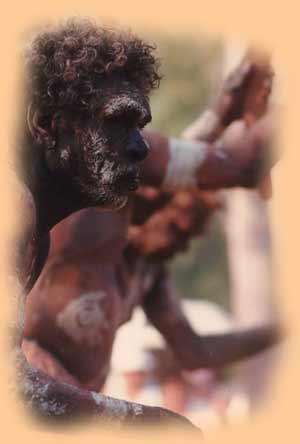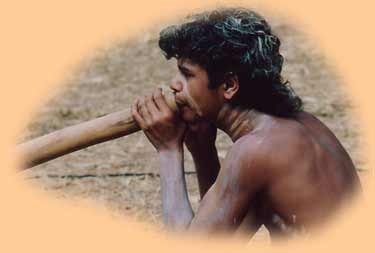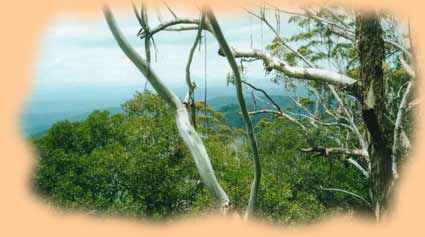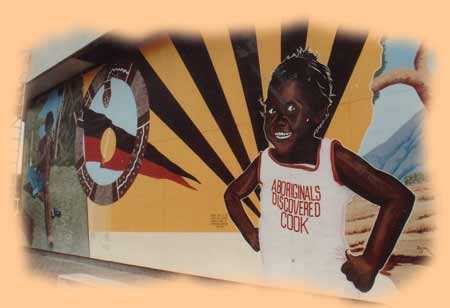 Australian Aboriginal culture can
claim to be the oldest continuous living culture on the planet. Australian Aboriginal culture can
claim to be the oldest continuous living culture on the planet.
Recent dating of the earliest known archaeological sites on the Australian continent - using thermo-luminescence and other modern
dating techniques - have pushed back the date for Aboriginal presence in Australia to at least 40,000 years. Some of the evidence points to dates
over 60,000 years old.
The hallmark of Aboriginal culture is 'oneness with nature'. In traditional Aboriginal belief systems, nature and landscape are
comparable in importance to the bible in Christian culture. Prominent rocks, canyons, rivers, waterfalls, islands, beaches and other natural features
- as well as sun, moon, visible stars and animals - have their own stories of creation and inter-connectedness. To the traditional Aborigine they
are all sacred: environment is the essence of Australian Aboriginal godliness.
Out of this deep reverence for nature Aborigines learned to live in remarkable harmony with the land and its animals.
It seems there's a lot our modern world can learn from these people.
Nomadic Brilliance
Traditional Australian Aborigines lived a nomadic life, following the seasons and the food.
With very few simple tools, used with incredible skill, the Aboriginal learned to live in the harsh and inhospitable Australian
outback.
 It's
possible that the first Aborigines in Australia hunted the Australian megafauna - giant kangaroos, giant wombat etc. to extinction. It's
possible that the first Aborigines in Australia hunted the Australian megafauna - giant kangaroos, giant wombat etc. to extinction.
Maybe that was when Aborigines learned to take care of natural resources and move to new hunting grounds before the old ones
are depleted beyond repair.
When at rest, Aborigines lived in open camps, caves or simple structures made from bark, leaves or other vegetation. Their technology
was both simple and sophisticated. Above all, it was appropriate for their way of life - ideally matched to the constraints of nomadic life.
The modern notion of possessions is alien to traditional Aboriginal culture. Material things were shared within groups. The idea
that an individual could 'own' land was foreign to Aboriginal thinking.
Clashes with colonists
When Europeans first began to colonise Australia, towards the end of the 18th century AD, they found cultures and environments
which, in hindsight, were of incalculable value.
Much of this ancient legacy has been destroyed forever in the subsequent two centuries.
Contact between new settlers, under imperial British rule, and Australia's indigenous people, led to the decimation of many Aboriginal
groups due to disease, dispossession and in tens of thousands of cases, outright murder.
As populations declined and were fragmented, many unique linguistic and cultural traditions as well as valuable knowledge about
the land and its fauna and flora were lost forever.
Land Theft
Seizure of Australia by British Imperial forces was claimed to take place under British law.
Even at that time, the British legal system had developed some traditions of fair dealings with native populations inside colonies.
 These
constraints were not applied on the ground in Australia. Invasion and blatant land theft by settlers were justified under the astonishing legal
fiction of "Terra Nullius" - the notion that Australia was effectively unoccupied before British colonisation. These
constraints were not applied on the ground in Australia. Invasion and blatant land theft by settlers were justified under the astonishing legal
fiction of "Terra Nullius" - the notion that Australia was effectively unoccupied before British colonisation.
The lack of indigenous systems of land ownership (in the European tradition of private land ownership) was used to give credence
the idea of Terra Nullius. The basic idea was that it was impossible to rob Aboriginal people of land, as they'd previously never owned
land.
Over two centuries, the continent was progressively stolen from Aboriginal people. Settlers moved in and appropriated the overwhelming
majority of Australia - either for private use or in the name of the British Crown.
Even after Australia was declared independent in 1901, Aborigines continued to be marginal to the new nation and were debarred
from becoming citizens by the 1902 Australian Constitution. Citizenship was granted to Aborigines only following a national referendum in 1967.
Legacy of racism
Racist attitudes to Australia's indigenous population evolved through different phases. In some places and on some occasions,
settlers behaved in a quite civilised way. In others, they practiced outright genocide. In between were a range of assimilationist and patronising
policies. Many of these helped deepen the plight of Aboriginal people and culture.
 As
recently as the 1950's, as many as one tenth of Aboriginal babies were removed from their natural parents and taken into foster care by non-Aboriginal
families, in the belief this was to everyone's benefit. As
recently as the 1950's, as many as one tenth of Aboriginal babies were removed from their natural parents and taken into foster care by non-Aboriginal
families, in the belief this was to everyone's benefit.
This quite recent forced removal of children on a massive scale - known as the 'Stolen Generation' - came to widespread attention
only in the late 1990's.
The current Australian Government has refused to make a formal apology over the 'Stolen Generation' (in contrast to President
Clinton's apology for the historical wrong of black slavery, and successive Australian Governments' demands for the Japanese to give a full apology
for crimes committed during World War 2).
Looking forward
Two centuries of dispossession and maltreatment have left deep scars in surviving Aboriginal communities. In life expectancy
and key health indicators, Aboriginal Australians as a whole lag far behind the average Australian population. A range of serious social problems
confront the leadership of Aboriginal Australia.
Yet there has also been major progress in recent times, as Australia's first peoples develop their own national and regional
institutions - and political strength - to meet the challenges of the modern era.
Struggles for Land Rights, for greater autonomy in the management of Aboriginal affairs, and for greater recognition and respect
to be given to traditional Aboriginal lore, have all met with partial success.
In 1991 Australia's High Court finally overturned the disgraceful legal myth of Terra Nullius. As a consequence, native
title to continuously settled land, which had until then been completely denied to Australian Aboriginal was "rediscovered" in Australian
law.
Throughout the 1990's, Australian Governments enacted legislation which greatly limited the applicability of High Court decisions
on native title.
This second dispossession of Aboriginal Australians - in favour of big mining and pastoral interests - is a blemish on recent
Australian history. Many people believe it should be challenged in the international courts, as it breaches Australia's international obligations
on human rights.
If you're interested, you can explore these issues in much greater detail via the references on the Aboriginal
Australia section of the Didjshop's Links Section.
We've also started an Aboriginal News Web log listing some
interesting recent media articles available on the web - please check it out.
We have also assembled a few Aboriginal Dreamtime stories from our artists' tribes. |

 Australian Aboriginal culture can
claim to be the oldest continuous living culture on the planet.
Australian Aboriginal culture can
claim to be the oldest continuous living culture on the planet. It's
possible that the first Aborigines in Australia hunted the Australian megafauna - giant kangaroos, giant wombat etc. to extinction.
It's
possible that the first Aborigines in Australia hunted the Australian megafauna - giant kangaroos, giant wombat etc. to extinction.  These
constraints were not applied on the ground in Australia. Invasion and blatant land theft by settlers were justified under the astonishing legal
fiction of "Terra Nullius" - the notion that Australia was effectively unoccupied before British colonisation.
These
constraints were not applied on the ground in Australia. Invasion and blatant land theft by settlers were justified under the astonishing legal
fiction of "Terra Nullius" - the notion that Australia was effectively unoccupied before British colonisation. As
recently as the 1950's, as many as one tenth of Aboriginal babies were removed from their natural parents and taken into foster care by non-Aboriginal
families, in the belief this was to everyone's benefit.
As
recently as the 1950's, as many as one tenth of Aboriginal babies were removed from their natural parents and taken into foster care by non-Aboriginal
families, in the belief this was to everyone's benefit.